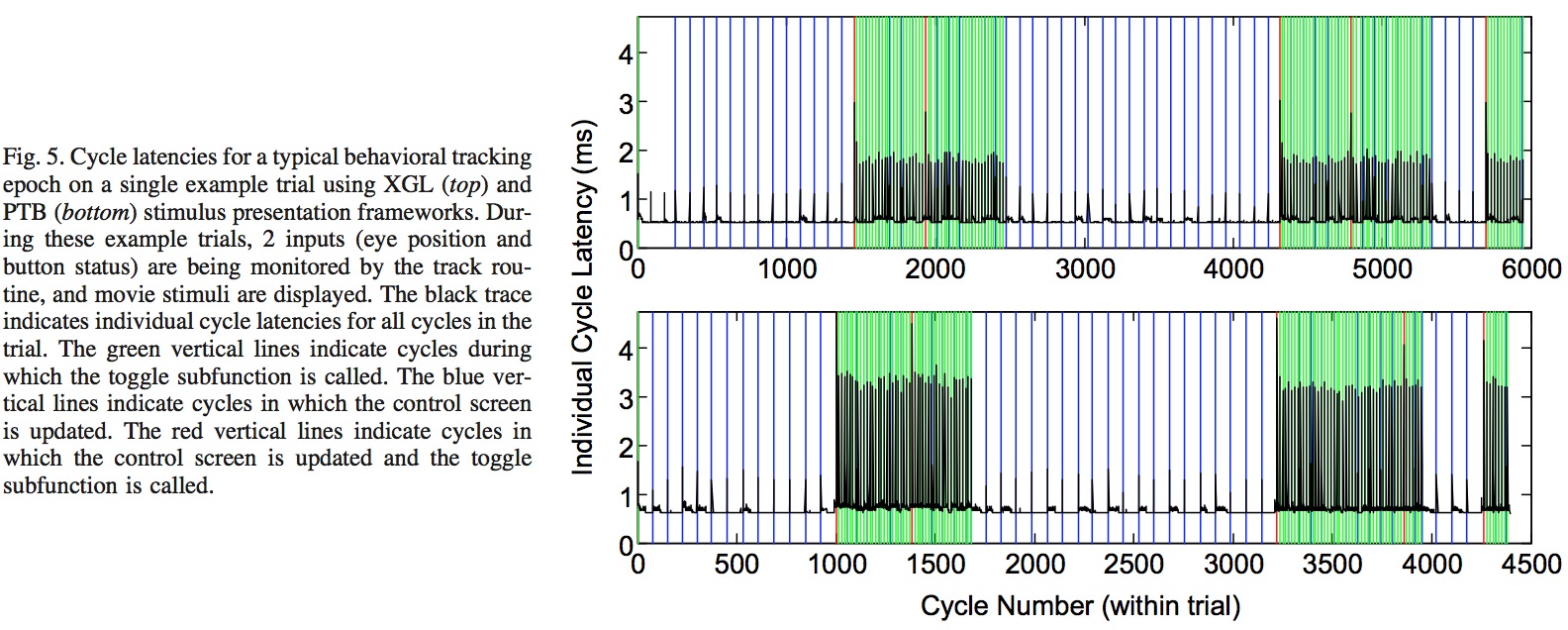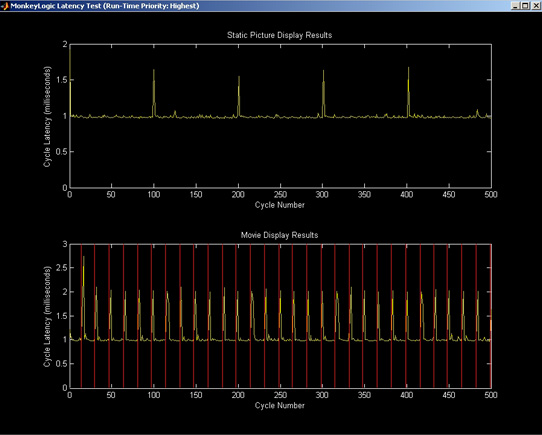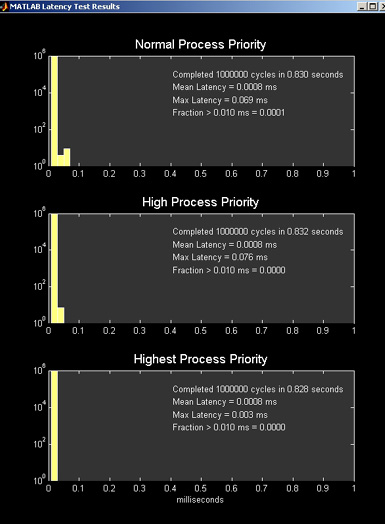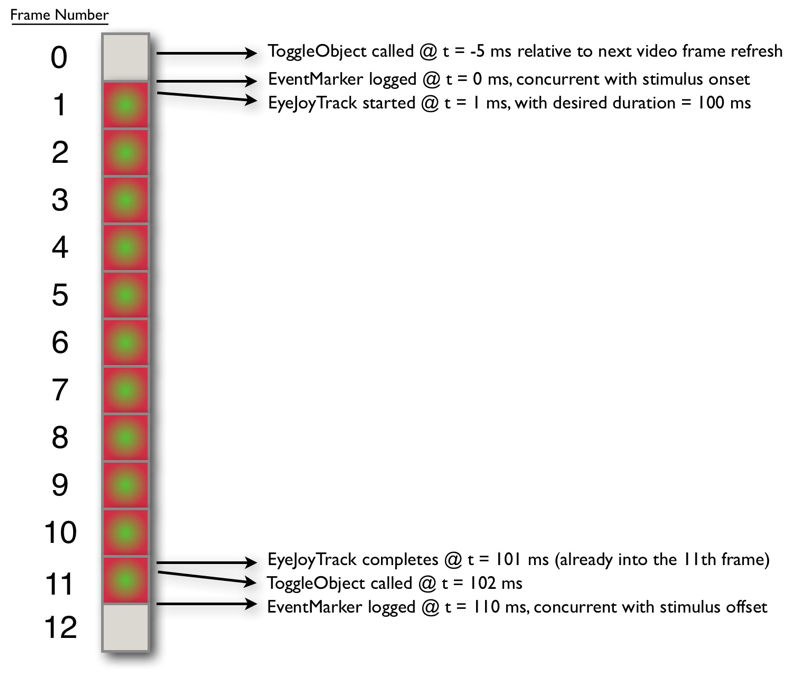Temporal Performance & Reliability
Reference Papers
Movie Performance
Benchmarking your System
Understanding Video Timing
NEW! MonkeyLogic User's Forum
Reference
Papers
Data regarding the temporal precision of MonkeyLogic is
available in the following publications. The first two detail specific performance characteristics of MonkeyLogic, and the third addresses the
general issues encountered and the strategies employed in trying to
achieve real-time control in a soft-real-time, interpreted-language
operating environment.
 |
High-Performance Execution of Psychophysical Tasks with Complex Stimuli in MATLAB.
Wael F. Asaad, Navaneethan Santhanam, Steve McClellan & David J. Freedman
Journal of Neurophysiology, 2013, Vol.109, pp 249-260.
|
 |
A flexible software tool for temporally-precise
behavioral control in MATLAB.
Wael F. Asaad & Emad N. Eskandar
Journal of Neuroscience Methods, 2008, Vol. 174, pp. 245-258.
|
 |
Achieving behavioral control with millisecond
resolution in a high-level programming environment.
Wael F. Asaad & Emad N. Eskandar
Journal of Neuroscience Methods, 2008, Vol.173, No.2, pp 235-240.
|
Addendum:
Resolution of certain timing inefficiencies (described in the
second reference, in Table 1). Note these are also explained and resolved in the first reference.
1) Calls to toggleobject
that ended with updates of the control-screen, to plot or erase symbols
reflecting the position of currently active visual stimuli, were noted
to incur a large temporal cost (up to 30 ms). This issue has been
resolved. The function "exit time" for toggleobject now averages less
than 1 ms. The DrawMode:Fast option for toggleobject is now, therefore,
unnecessary.
2) The first cycle in any behavioral tracking episode in eyejoytrack was noted to
take much longer than subsequent ones due to the plotting of target
rings around the relevant objects (second reference, section 5.3), up
to nearly 30 ms. This issue has been resolved. Plotting the target
rings now takes less than 2 ms, on average, so that the first tracking
cycle latency is similar to subsequent cycle latencies when the eye- or
joystick trace is updated.
3) The trial exit time (which averaged 10-20 ms) is now subtracted
from the inter-trial-interval such that the actual ITI time now better
approximates the desired ITI time.
Corrigendum:
In the second reference ("A flexible software tool..."), the example
code for picking out the first instance of n consecutive
correct trials from an error vector e (page 248) is
incorrect. It should read:
f = find([1 logical(e) 1]);
t = min(f(diff(f) > n));
Note that the red "f" in the second line was miscoded as "find" in
the published text.
Movie
Performance
The ability to
present movie stimuli (and translating images & movies) while
simultaneously tracking behavior has been added, thanks to Markus
Siegel, David Freedman, and Steve McClellan. As one would expect, the
time required to update video frames does have a cost on the ability to
rapidly sample behavior. Fortunately, this cost is relatively small.
For example, shown here are the consecutive cycle latencies (i.e., time
between behavioral data samples) while tracking behavior with a movie running (From Asaad, Santhanam, McClellan and Freedman, 2013):

The red lines indicate those cycles in which a video
update was performed to advance the frames (and position) of the
movies. First, notice that no frames are missed (there is a red line
every 10 ms for this case in which the video refresh rate was 100 Hz).
Second, note that the latencies on those cycles in which a video update
was performed took longer (between 2 and 3 ms) than those cycles
without such video updates (~1 ms). This means that there are gaps in
the on-line tracking of behavior equal to these times, potentially
lasting up to nearly 3 ms. However, there is no temporal slippage;
these gaps are simply intervals in which MonkeyLogic is temporarily
"blind" to changes in the behavioral signals. The average latency
across all cycles was 1.15 ms.
It is not unusual to have skipped frames during the
first presentation of a movie in only the first trial, especially when
using higher frame rates (this will be indicated by a warning message);
however, we have found subsequent movie presentations in the following
trials do not produce any skipped frames at rates of at least up to 100
Hz.
For a comparison of what this figure looks like when
tracking behavior without concurrently showing movies, refer to Figure
3a of the second reference,
above. In that figure, the periodic spikes in latency are less
frequent, and due solely to the updating of the control-screen. The
first cycle in that figure experiences a prolonged latency (~23 ms) due
to updating the control-screen with symbolic representations of the
visual stimuli; when presenting movies, this is automatically disabled
such that there are no skipped frames (explaining why the longest
latency here was under 3 ms).
This test was performed on the same machine used in the
references above; much faster (and slower) computers are available, so
performance will vary (see benchmarking,
below).
Benchmarking
your System
There are two ways built-in to MonkeyLogic to help
benchmark a particular system (both found in the task panel of the main menu):
- MonkeyLogic Latency Test - This button will
become enabled once a Conditions file has been loaded along with its
settings. Using these settings, a benchmarking trial will be run to
determine how quickly the behavioral signal can be sampled while
presenting a static picture and while presenting a movie (the latter
must perform video updates that momentarily interrupt behavioral
sampling, as shown above). The measured times will vary as a function
of the number and type of I/O assignments made (e.g., if no analog
inputs are used, cycle latencies will be much shorter), and as a
function of the number of analog input boards used (cycle latencies
will be longer when two DAQ boards are used; nevertheless, this is
preferred for reasons described in the first reference, above). The
results will be plotted in a new figure window (as shown below). This
figure is useful to determine the actual behavioral-sampling
performance of one's system in the context of a real trial at the
currently-selected I/O settings.

- Matlab Latency Test - This button simply
time-stamps an empty-loop one million times and plots the resulting
cycle latencies for each of the three process priorities available for
use by MonkeyLogic (i.e., "Normal", "High" and "Highest."). This is
useful to determine if there are sporadic high latencies caused by the
operating system or background applications. Generally, mean latencies
across priority settings will differ by a small amount, whereas maximum
latencies will vary by several tenths of a millisecond or more. Shown
below is an example of a resulting figure.

Understanding Video Timing
Because video refreshes are periodic events, trying to specify particular time intervals within a behavioral task is subject to quantization according to the video refresh interval. When the overhead of specific function calls is added to the mix, seemingly unexpected timing intervals may result. For example, if you used a video refresh rate of 100 Hz and wanted to display a stimulus for exactly 100 ms with some sort of behavioral tracking in-between, you'll find that the actual interval MonkeyLogic runs is 110 ms (one extra frame is added). The reason is depicted in this diagram:

This diagram explains why specifying a certain timing interval can result in an extra video frame. Here, the user wished to specify a 100 ms time interval, spanning exactly 10 video frames. However, 11 video frames are always displayed. This is caused by very slight delays between the toggleobject and eyejoytrack function calls. Specifically, the delays between the eventmarker logged by toggleobject at time t = 0 ms and eyejoytrack execution at time t = 1 ms is due to overhead in completing and exiting the toggleobject function and overhead entering and starting the eyejoytrack function. At the end of that interval, there is additional overhead exiting the eyejoytrack function and entering the toggleobject function. All of these slight delays are additive, pushing the end of the intended 100 ms interval into the next video frame. The depicted one millisecond delay between functions is used as an example (the actual time will vary depending on the system on which MonkeyLogic is running); but even if this were only a 0.1 millisecond delay, the same result would ensue. So long as the next frame has started by even the smallest amount of time, an extra frame must be added to be able to enact the next toggleobject command.
Importantly, these things hold true if one is using toggleobject with the "eventmarker" option, causing toggleobject to wait until a vertical blank before time-stamping that event to coincide with the actual stimulus onset or offset. If toggleobject were called without the eventmarker option, then there would be no gap (here, for example, between t = -5 and t = 0) and program execution would be allowed to continue immediately after the visual stimuli have been cued, even before the next video refresh actually took place. In that case, immediately calling the separate eventmarker command directly from the timing script would produce a time-stamp just after t = -5, and would not therefore indicate the actual time of visual stimulus onset.
In this example, to achieve the desired interval of exactly 100 ms, the best strategy is to specify an interval that is slightly shorter (approximately by half a video frame usually works). Here, that would mean specifying an interval of ~95 ms. That way, the second toggleobject command is issued sufficiently before the next refresh to queue the visual stimuli to turn off at the desired time (t = 100 ms).
|